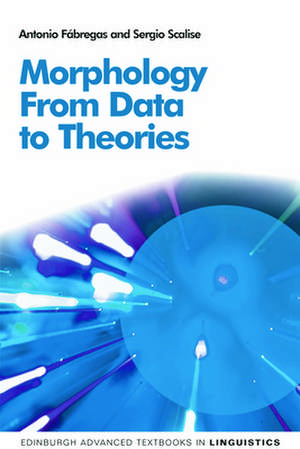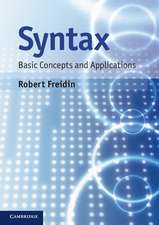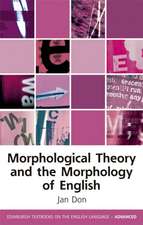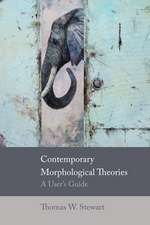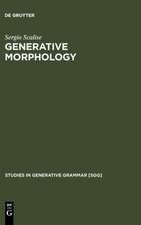Morphology: Edinburgh Advanced Textbooks in Linguistics
Autor Antonio Fabregas, Sergio Scaliseen Limba Engleză Paperback – 10 mai 2012
| Toate formatele și edițiile | Preț | Express |
|---|---|---|
| Paperback (1) | 165.91 lei 3-5 săpt. | +35.01 lei 7-13 zile |
| EDINBURGH UNIVERSITY PRESS – 10 mai 2012 | 165.91 lei 3-5 săpt. | +35.01 lei 7-13 zile |
| Hardback (1) | 643.86 lei 6-8 săpt. | |
| EDINBURGH UNIVERSITY PRESS – 10 mai 2012 | 643.86 lei 6-8 săpt. |
Preț: 165.91 lei
Preț vechi: 185.99 lei
-11% Nou
Puncte Express: 249
Preț estimativ în valută:
31.75€ • 33.15$ • 26.27£
31.75€ • 33.15$ • 26.27£
Carte disponibilă
Livrare economică 15-29 martie
Livrare express 01-07 martie pentru 44.100 lei
Preluare comenzi: 021 569.72.76
Specificații
ISBN-13: 9780748643134
ISBN-10: 0748643133
Pagini: 209
Ilustrații: black & white illustrations
Dimensiuni: 155 x 231 x 15 mm
Greutate: 0.34 kg
Editura: EDINBURGH UNIVERSITY PRESS
Seria Edinburgh Advanced Textbooks in Linguistics
ISBN-10: 0748643133
Pagini: 209
Ilustrații: black & white illustrations
Dimensiuni: 155 x 231 x 15 mm
Greutate: 0.34 kg
Editura: EDINBURGH UNIVERSITY PRESS
Seria Edinburgh Advanced Textbooks in Linguistics
Notă biografică
Cuprins
Abbreviations; Foreword; 1. Morphology: definitions and basic concepts; 1.1. What is morphology?; 1.1.1. Its object of study; 1.1.2. Morphology's place in grammar; 1.1.3. Differences between the lexicon and morphology; 1.2. Classes of morphemes; 1.2.1. Classes of affixes; 1.3. Subdivisions of morphology; 1.3.1. Inflection; 1.3.2. Word formation: derivation and compounding; 1.4. The spell out of morphemes; 1.4.1. Allomorphy; 1.5. Productivity; 2. Morphological units; 2.1. Morphemes; 2.2. Words; 2.3. The debate on the existence of morphemes; 2.3.1. Replacive and substractive morphology; 2.3.2. Mismatches between grammatical features and their exponents; 2.3.3. Cranberry morphemes; 2.3.4. Priscianic word formation; 2.3.5. Paradigmatic motivation of meaning; 2.4. Other units; 2.4.1. Roots and stems; 2.4.2. Constructions 2.4.3. Templates; 2.5. Correlations between morphemes and morphs and morphological typology; 3. Morphological structures; 3.1. The motivation for morphological structures; 3.1.1. Evidence in favour of word internal structure; 3.2. The properties of morphological structures; 3.2.1. The concept of head; 3.2.2. The position of the head; 3.2.3. Binary branching; 3.3. Arguments against morphological structures; 3.3.1. A-morphous morphology; 3.3.2. Exocentricity; 3.3.3. Bracketing paradoxes; 3.3.4. Double base; 3.3.5. Parasynthesis; 4. Inflectional processes; 4.1. Properties of inflection; 4.2. Inflection and grammatical categories; 4.2.1. A comparison of five languages; 4.2.2. Non-inflected categories: prepositions, conjunctions and adverbs; 4.3. Desinences and theme vowels in grammar; 4.3.1. The status of gender and the notion of desinence; 4.3.2. Theme vowels; 4.4. Paradigms; 4.4.1. Syncretism; 4.4.2. Defectivity; 4.4.3. Suppletion; 4.4.4. Patterns of irregularity; 5. Derivational processes; 5.1. Properties of derivation; 5.2. Category changes; 5.2.1. Nominalisations; 5.2.2.Verbalisations; 5.2.3. Adjectivalisations; 5.3. Semantic changes; 5.4. Category change without formal marking: conversion; 5.5. Argument structure changes; 5.5.1. Lexical alternations; 5.6. Questions raised by the analysis of derivational processes in a single language; 5.7. The limits between inflection and derivation; 5.7.1. Appreciative morphology; 5.7.2. Hybrid categories; 6. Compounding: Other word formation processes; 6.1. Properties of compounds; 6.2. Basic classes of compounds; 6.2.1. Classes according to the relation established between the two elements; 6.2.2. Synthetic compounds; 6.2.3. Parasynthetic compounds; 6.2.4. Co-compounds; 6.3. Compounding between syntax and morphology; 6.3.1. Some differences between phrases and compounds; 6.3.2. Intermediate cases; 6.4. Compounds and grammatical categories: Japanese and English; 6.5. Other word-formation processes; 6.5.1. Clipping; 6.5.2. Reduplication; 6.5.3. Acronymy; 6.5.4. Blending; 7. Relations between morphology and syntax; 7.1. The place of morphology in grammar: Lexicalism and Constructionism; 7.1.1. Lexicalist theories; 7.1.2. Constructionism; 7.2. The Generalised Lexicalist Hypothesis: data; 7.2.1. Syntactic material inside words: the No Phrase Constraint; 7.2.2. Non-morphological processes and the internal structure of words; 7.2.3. Absence of movement and the theory of syntactic domains; 7.2.4. Absence of coreference to word-internal constituents; 7.3. The relation between syntax and morphology in diachrony: morphologisation; 8. Morphology's relation with phonology and semantics; 8.1. Restrictions imposed by phonology to morphology; 8.2. The phonological materialisation of morphemes; 8.2.1. Morphology and phonology feed each other: Lexical Strata; 8.2.2. Morphology is independent from phonology: the Separation Hypothesis; 8.2.3. Morphology precedes phonology: the Late Insertion Hypothesis; 8.2.4. Post-syntactic morphological operations in Distributed Morphology; 8.3. Accounting for allomorphs: localism and globalism; 8.4. The linearization of morphological structure: the order of morphemes; 8.4.1. Syntactic accounts; 8.4.2. Semantic accounts; 8.4.3. Purely morphological accounts; 8.4.4. Phonological accounts; 8.4.5. Parsing-based accounts; 8.5. The meaning of words and affixes; 8.5.1. The meaning of units is decomposable; 8.5.2. Semantic atomicity; 8.5.3. Do affixes have a meaning of their own?; 8.6. Compositionality and demotivation of meaning; 8.6.1. The demotivation of meaning; 8.6.2. Dividing structures and concepts: two types of meaning; 8.6.3. How to represent demotivation; Answers to the exercises; References; Subject index.
